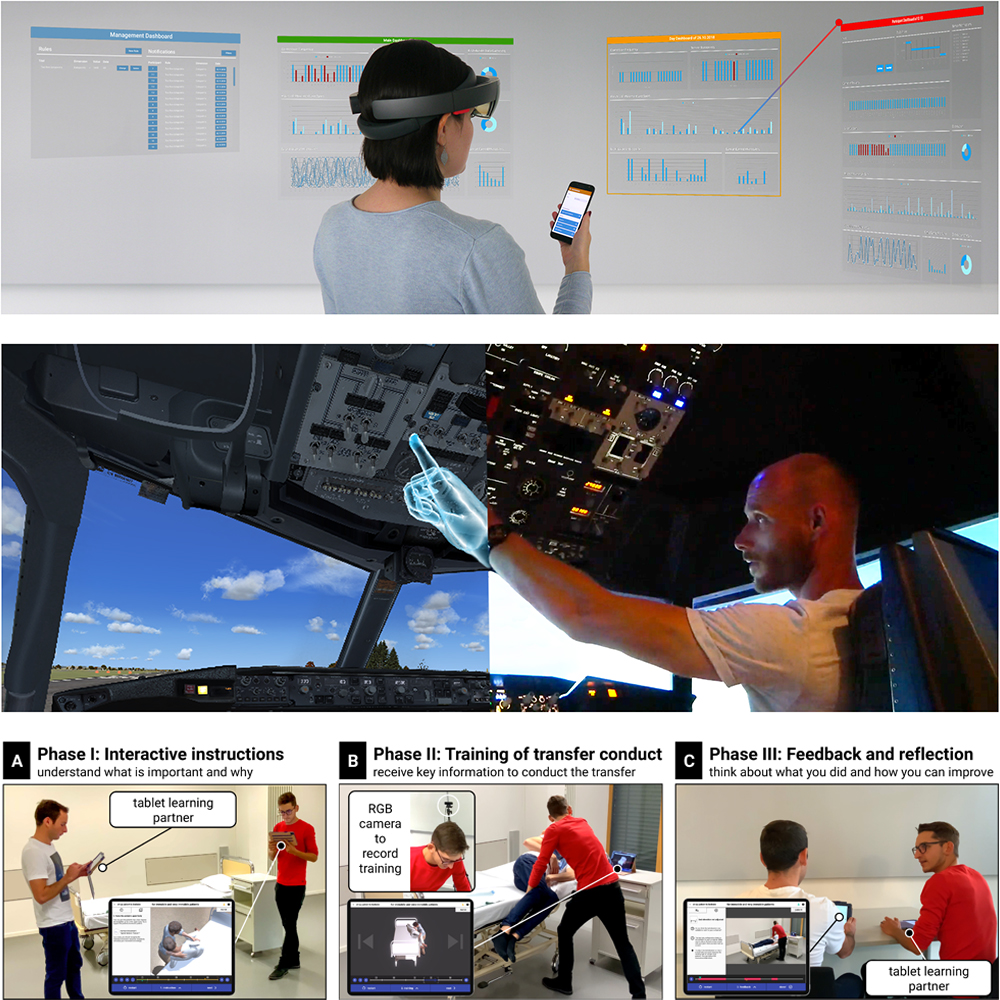
2 Papers and 1 Invited Talk at MuC'21
We are happy to announce that we will present in total 3 papers at this year's Mensch und Computer (MuC'21) in Ingolstadt: 2 MuC papers and 1 invited talk.
_ _ _ _ _
MCI-Session 02: Work Assistance (Invited Talk)
Maximilian Dürr1, Marcel Borowski2, Carla Gröschel1, Ulrike Pfeil1, Jens Müller1, Harald Reiterer1
1Universität Konstanz, Germany; 2Aarhus University
Nurses frequently transfer patients as part of their daily work. However, manual patient transfers pose a major risk to nurses’ health. Although the Kinaesthetics care conception can help address this issue, existing support to learn the concept is low. We present KiTT, a tablet-based system, to promote the learning of ergonomic patient transfers based on the Kinaesthetics care conception. KiTT supports the training of Kinaesthetics-based patient transfers by two nurses. The nurses are guided by the phases (i) interactive instructions, (ii) training of transfer conduct, and (iii) feedback and reflection. We evaluated KiTT with 26 nursing-care students in a nursing-care school. Our results indicate that KiTT provides a good subjective support for the learning of Kinaesthetics. Our results also suggest that KiTT can promote the ergonomically correct conduct of patient transfers while providing a good user experience adequate to the nursing-school context, and reveal how KiTT can extend existing practices.
_ _ _ _ _
IDIAR: Augmented Reality Dashboards to Supervise Mobile Intervention Studies
Katja Vock, Sebastian Hubenschmid, Johannes Zagermann, Simon Butscher, Harald Reiterer
University of Konstanz, Germany
Mobile intervention studies employ mobile devices to observe participants’ behavior change over several weeks. Researchers regularly monitor high-dimensional data streams to ensure data quality and prevent data loss (e.g., missing engagement or malfunctions). The multitude of problem sources hampers possible automated detection of such irregularities – providing a use case for interactive dashboards. With the advent of untethered head-mounted AR devices, these dashboards can be placed anywhere in the user’s physical environment, leveraging the available space and allowing for flexible information arrangement and natural navigation. In this work, we present the user-centered design and the evaluation of IDIAR: Interactive Dashboards in AR, combining a head-mounted display with the familiar interaction of a smartphone. A user study with 15 domain experts for mobile intervention studies shows that participants appreciated the multimodal interaction approach. Based on our findings, we provide implications for research and design of interactive dashboards in AR.
_ _ _ _ _
MCI-Session 06: Virtual Reality
Comparison between Virtual Reality and Physical Flight Simulators for Cockpit Familiarization
Stefan Auer1, Jens Gerken2, Harald Reiterer3, Hans-Christian Jetter4
1School of Informatics, Communication and Media, University of Applied Sciences Upper Austria, Hagenberg, Austria; 2Westphalian University of Applied Sciences, Gelsenkirchen, Germany; 3Computer and Information Science, University of Konstanz, Konstanz, Germany; 4Institute for Multimedia and Interactive Systems, University of Lübeck, Lübeck, Germany
Airlines and flying schools use high-end physical flight simulators (PFS) to reduce costs and risks of pilot training. However, such PFS with full-scale cockpits have very high acquisition and operation costs. In contrast, recent consumer-grade and off-the-shelf soft- and hardware can be used to create increasingly realistic virtual reality flight simulators (VRFS) that could potentially serve as cost-efficient and flexible alternatives. We present a user study with 11 participants to determine whether consumer-grade VRFS can supplement or even replace a PFS during cockpit familiarization training (CFT). We compared a full-scale Boeing 737-800NG PFS with a VRFS based on off-the-shelf flight simulator software combined with a consumer-grade head-mounted display and either finger tracking or a handheld controller as input device. Participants performed instrument reading tasks and check procedures from the aircraft’s operating manual. We did not observe statistically significant differences in successful instrument reading tasks, error rates and task completion between PFS and VRFS during CFT. However, we found that VRFS’ Mental Demand, Physical Demand, Effort, task completion times, and levels of simulator sickness were significantly higher and exceeded acceptable levels. We conclude that future VRFS research needs to improve soft- and hardware for interacting with simulated switches and identify and reduce sources of simulator sickness.
